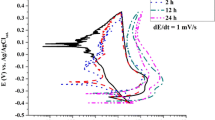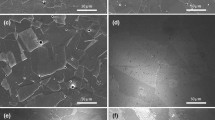Abstract
Sensitization can be simply defined as the susceptibility of an alloy, specifically austenitic stainless steel, to corrosion at grain boundaries. A detailed study on types 304 stainless steel has been carried out to correlate the degree of sensitization measured by electrochemical potentiokinetic reactivation test (EPR) with the susceptibility to intergranular corrosion. In this study four different heat treatments were given to alloys, i.e., solution annealed (SA) at 1020 °C for 1 h, then quenched in water; also then heat-treated in air at 620 °C for 15, 30, and 60 min. The electrolyte for the EPR tests was 1.0 N H2SO4 solution containing 0.01 M KSCN. Potentiodynamic curves from passive to active regions in deaerated solution at room temperature were obtained at a scan rate of 1.67 mV/s (6 V/h), after the passivation at 200 mV versus (SCE) for 2 min then the polarization was conducted. The criterion used to distinguish between sensitized and non-sensitized specimens is the activation charge Pa, the peak current density, Ph, in the active state, and Flade potential Ef at which the active curve breaks upward. The results indicated that the longer the sensitization time the higher the activation charge (Pa), and the higher the peak current density in the active state (Ph). The results indicated that, the EPR is more sensitive than the chemical method for measuring the degree of sensitization.
Access provided by Autonomous University of Puebla. Download conference paper PDF
Similar content being viewed by others

Keywords
- Austenitic Stainless Steel
- Chromium Carbide
- Ammonium Persulfate
- Peak Current Density
- Intergranular Corrosion
These keywords were added by machine and not by the authors. This process is experimental and the keywords may be updated as the learning algorithm improves.
1 Introduction
Sensitization can be simply defined as the susceptibility of an alloy, specifically austenitic stainless steel, to corrosion at grain boundaries. Grain boundaries are disordered misfit regions separating grains of different crystallographic orientation. Intergranular corrosion of austenitic stainless steels is thought to be caused by one of three things: impurities at the grain boundaries, enrichment of one of the alloying elements, or the depletion of one of these elements in the grain boundary area. However, the most universally accepted theory for intergranular corrosion is based on the depletion of chromium in the grain boundary areas [1].
The depletion of Chromium at the grain boundaries results when the temperature is raised into the 400–850 °C range or during slow cooling from the austenitic temperature range, and is caused by the formation of Cr23C6. This leaves the Chromium content near the grain boundaries lowered to the point where the depleted area approaches ordinary steel rather than stainless steel.
Historically intergranular corrosion was recognized and studied using acid immersion tests. Acid tests exist which have been standardized by the ASTM. The Copper Copper sulfate–sulfuric acid test (ASTM A393-63), commonly known as the strauss test.
Recent research on electrochemical techniques for studying the susceptibility of stainless steels to intergranular attack indicate that the corrosion is primarily under anodic control. That is, attack is determined by the availability of anodic sites at the grain boundaries. It has been found that the anodic polarization curve of a sensitized stainless steel is different than the curve for a non-sensitized stainless steel [2, 3].
Trends in the electrochemical potentiodynamic reactivation method (EPR) has been investigated by a number of researchers [4–8]. They studied the measurement of the area that defined the active-passive region as a basis for assessing the degree of sensitization in stainless steel. Their study was prompted by the desirability of having a rapid, non-destructive field test for determining the degree of sensitization. They concluded that the EPR test remains the most sensitive electrochemical testing technique in detecting the degree of sensitization.
2 Materials and Methods
Degree of sensitization (DOS) The DOS studies were conducted on type 304 stainless steel using an electrochemical technique called the Electrochemical Potentiokinetic Reactivation method (EPR). The chemical composition of this alloy is given in Table 1.
In this study four different heat treatments were given to the alloys, i.e. solution annealed (SA) at 1020 °C for 1 h, then quenched in water; also then heat-treated in air at 620 °C for 15, 30, and 60 min. The electrolyte for the EPR tests was 1.0 NH2SO4 solution containing 0.01 M KSCN. The specimens were polished through 1 alumina slurry. Potentiodynamic curves from passive to active regions in deaerated solution at room temperature were obtained at a scan rate of 1.67 mV/s (6 V/h), after the passivation at 200 mV (SCE) for 2 min. The polarization was conducted under the conditions given in Table 2. The criterion used to distinguish between sensitized and non-sensitized specimens is the activation charge Pa (given by the integrated area below the peak of the reactivation curve), the peak current density Ph, in the active state, and the Flade potential Ef at which the active curve breaks upward. Sensitized steels show higher (Pa) and (Ph) values and more positive (Ef) values than non-sensitized steels.
Metallography The specimens that were used for the Electrochemical Potentiokinetic Reactivation tests were electrolytically polished and etched using 60 % H3PO4 + 40 % H2SO4 and 10 % ammonium persulfate respectively. The microstructure was observed using light microscopy at magnifications of 100× and 1000×.
ASTM A262-Practice E The degree of sensitization was observed in this investigation by the use of the Copper-Copper sulfate-sulfate acid test. The test specimens were exposed to the boiling test solution for 24 h. Then the damage was assessed by bending the specimens through 180 and examining the outside surface for accentuated intergranular penetrations. The specimens sensitized for 30 and 60 min at 620 °C exhibited fissuring when bent, which is evidence of intergranular attack.
3 Results and Discussions
The susceptibility to intergranular corrosion was evaluated electrochemically by developing potential sweep from passive to the active region (reactivation) in 1.0 NH2SO4 + 0.01 M KSCN at 25 °C as the test solution.
The results of the Electrochemical potentiokinetic reactivation test (EPR) have been summarized in Table 3 and shown in Fig. 1. It can be seen that the longer the sensitization time the higher the activation charge (Pa) the peak current density in the active state (Ph) and that the activation charge appear to be more sensitive. It is obvious that considerable difference exists between the solution quenched (SQ) and the sensitized specimens. For Type 304 stainless steel, the sensitization is reflected in the variable degree of grain boundary attack (pitting) after etching the specimens using 10 % ammonium persulfate as shown in their microstructures, Figs. 2, 3, 4 and 5. The pitting attack along the grain boundaries, which is probably connected to the carbide structure of this material, and the amount of carbide precipitation, supports the idea that attack is associated with the Cr-depleted area. The results of ASTM A262-E indicate that specimens sensitized for 30 and 60 min exhibited fissuring when bent through 180, which is evidence of intergranular attack. These results agree quite well with the EPR measurements. In addition, the A262-E results for the 15 min sensitized specimens indicate doubtful test results, which is in contrast to that determined by EPR testing.
Precipitation of chromium carbides was suspected in specimen sensitized for 15 min. Observation under a TEM did not, however, reveal precipitates of chromium carbides but chromium was seen diffusing toward the grain boundaries as compared to a solution quenched specimen of the same alloy. This seems to reaffirm that the EPR is a very sensitive technique for measuring the degree of sensitization (susceptibility to intergranular corrosion).
4 Conclusions
The objective of this investigation was to determine the feasibility of the Electrochemical Potentiokinetic Reactivation technique (EPR) for measuring the degree of sensitization.
Admittedly, additional work needs to be done before a high level of confidence in the EPR measurement technique is achieved. The EPR technique is more sensitive than the chemical method for measuring the degree of sensitization in Type 304 Stainless Steel. As a comparison, the chemical method would probably have accepted Type 304 stainless steels sensitized for 15 min, while the EPR technique rejected this material.
References
M.G. Tontana, N.D. Greene, Corrosion Engineering (McGraw-Hill, Inc. New York, 1979)
W.L. Clark, V.M. Romero, J.C. Danko, Detection of sensitization in stainless steel using electrochemical technique. Paper presented at NACE corrosion 77. Report No 180 (1979)
W.L. Cowan, R.L. Walker, Detection of sensitization in stainless steel using electrochemical technique. General electric report for US—NRC. CEAP Z1382 (1976)
V. Cihal, J. Klimsza, Elaboration of the EPR method for high alloyed steel. In Proceedings of the EUROCORR, 96 Nice XP5, (1996), pp. 1–4
V. Cihal, J. Hubdckove, J. Kubelka, K. Mazanec, The potential polarization method for the evaluation of martenzite-austenite stainless steels. Mater. Chem. Phys. 11, 279 (1984)
J.R. Scully, R.Q. Kelly, An electrochemical test for detecting the intergranular corrosion susceptibility of a duplex stainless steel. Corrosion (NACE) 42, 537 (1986)
G.H. Wagner, The EPR technique to evaluate special questions on the corrosion resistance of high alloyed materials. Werkstoffe u. Korrosion 52, 15 (2001)
V. Cihal, S. Lasck, M. Blahetova, E. Kalabisova, Z. Krhutova, Trends in the electrochemical polarization potentiodynamic reactivation method—EPR. Chem. Biochem. Eng. Q 21(1), 47–54 (2007)
Author information
Authors and Affiliations
Corresponding author
Editor information
Editors and Affiliations
Rights and permissions
Copyright information
© 2015 Springer International Publishing Switzerland
About this paper
Cite this paper
Abuzriba, M.B., Musa, S.M. (2015). Measuring the Degree of Sensitization (DOS) Using an Electrochemical Technique. In: Polychroniadis, E., Oral, A., Ozer, M. (eds) 2nd International Multidisciplinary Microscopy and Microanalysis Congress. Springer Proceedings in Physics, vol 164. Springer, Cham. https://doi.org/10.1007/978-3-319-16919-4_26
Download citation
DOI: https://doi.org/10.1007/978-3-319-16919-4_26
Published:
Publisher Name: Springer, Cham
Print ISBN: 978-3-319-16918-7
Online ISBN: 978-3-319-16919-4
eBook Packages: Physics and AstronomyPhysics and Astronomy (R0)








